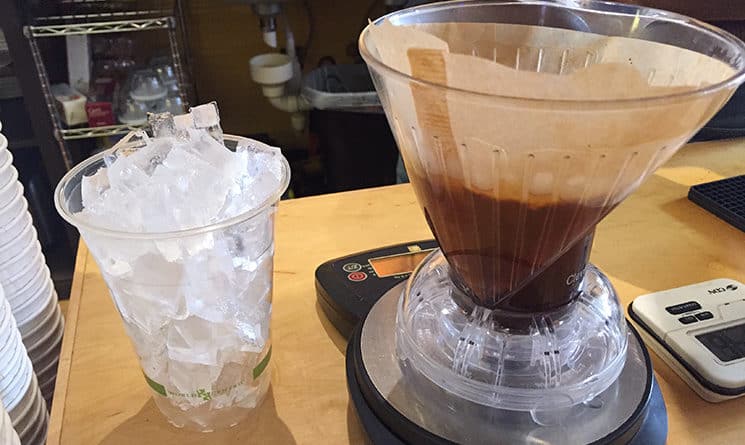On a Tuesday in late March, Nova Mullineaux, owner of Adelle’s Coffeehouse, posted a simple message on the Dover café’s Facebook page: “Cold brew, guys.”
Later that day, “we had a line out the door,” Mullineaux said.
Such is the power of cold brew, a chilled coffee concoction that is iced coffee’s richer, more caffeinated cousin. The appearance of both in local coffee shops, along with other iced beverages, is a sign that winter is truly over.
What is cold brew? It’s coffee that’s iced, but please don’t confuse it with iced coffee. The main difference between the two is in the name: cold brew is brewed using cold or room-temperature water, while iced coffee is brewed hot and then cooled. Cold-brewed coffee is less acidic than coffee that’s brewed hot, and the result is a flavor that’s smoother and more chocolaty.
Cold-brew coffee is usually brewed with coarsely ground beans, and it’s steeped for long periods of time — six to eight hours is typical. The result is a highly concentrated form of coffee. Cold brew is usually cut with milk or water when served, and, according to Mullineaux, the caffeine content is higher than hot-brewed coffee.
“I think it’s the most addictive form of coffee,” she said. “You’re getting the same volume of liquid but with a much higher concentration (of caffeine).”
At D-Squared Java in Exeter, owner Dan Demers brews cold brew in big five-gallon buckets. It takes five pounds of coffee, three to four gallons of water, and hours of steeping to make a batch of cold brew. But it’s worth it.
“It’s more mellow. It’s very pleasing to drink cold. It’s smooth and has a good mouth-feel,” Demers said.
And, because cold brew is concentrated coffee, it’s versatile — cold brew can be used in cocktails or baked goods or added to other iced drinks for an extra punch. At D-Squared, Demers also offers cold brew poured through a nitro tap — the same way you might get a Guinness or stout at your local bar.
“It’s kind of at the leading edge of the coffee scene. It comes out like a nice, dark stout,” Demers said. “(The nitro) gives it a creamy effervescence.”
“Once we turn people on to cold brew … they almost never go back.” — Nova Mullineaux
At White Heron Tea and Coffee in Portsmouth, Jonathan Blakeslee brews his cold brew using both hot and cold water. There are plenty of variations, he said, and part of the allure of working with coffee and tea is that there are countless variables that can change the flavor of a drink.
“There are so many ways to do things, and everybody can find the thing they want to focus on,” he said.
Both cold brew and iced coffee are customizable. Different cafes brew each in different ways. And there’s room to get fancy. At D-Squared, Demers sells iced coffee by the cup. It’s made with a Clever coffee dripper — a cone-shaped apparatus into which you put a paper filter, coffee grounds, and hot water. After the coffee has steeped for about two minutes, the dripper is placed over a cup of ice. A plug on the bottom of the dripper opens up and the coffee concentrate drips over the ice. Some of the ice melts, which cuts the concentrate, and the result is a perfectly chilled cup of coffee.
The single-cup method lets coffee drinkers tweak the recipe until they find a perfect cup, Demers said. It also helps maintain the coffee’s natural flavors. A batch of cold brew, for example, will taste rich and chocolaty no matter what the beans’ original flavor. But a single-cup serving of iced coffee will carry distinct flavors — for example, an iced cup of Kenyan coffee at D-Squared carries notes of tomato and lime.
Pour-over iced coffee is time-intensive, at least compared to grabbing a quick cup to go. D-Squared offers other pour-over methods for hot coffee, which Demers said are popular among serious coffee aficionados.
“We’ll sell a couple a day,” he said. It takes a lot more training (for baristas), and it takes a lot more time. Once you’re doing this, you’re doing it for the next five minutes,” he said.
Demers and Mullineaux said both cold brew and iced coffee are popular with customers — it’s just a matter of taste. Adding milk and sugar to cold brew doesn’t affect the flavor much, for example, while a single-pour serving of iced coffee will likely taste better without anything added. However, for customers who’ve never had it, that first cup of cold brew can be something of an awakening, according to Mullineaux.
“Once we turn people on to cold brew … they almost never go back,” she said.

